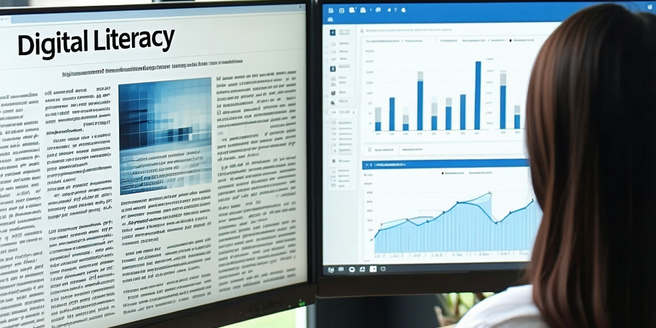Understanding Digital Literacy Today
Digital literacy has emerged as a crucial competence in the modern world, where digital interaction is ubiquitous and constantly evolving. It involves more than merely understanding how to use technology; it requires a comprehension of digital ethics, data privacy, and online etiquette. This section of digital literacy empowers individuals to make informed choices while navigating the digital landscape. With increasingly complex devices and software, digital literacy enables individuals to utilize these tools effectively for communication, work, and learning. It’s not limited to just using digital gadgets but extends to understanding how these technologies impact society and individuals. Developing digital literacy ensures that people can participate confidently and safely in an online environment, understanding the potential risks and benefits that technology can bring. Thus, it is a foundational skill in today’s digital age.
Essential Skills for the Digital Age
In the digital age, possessing specific skills is essential to thriving in a technology-driven environment. Critical thinking and problem-solving are paramount, as they help individuals analyze information and make sound decisions online. Effective communication through digital platforms is another key skill, necessitating the ability to convey messages clearly and respectfully across various mediums. Additionally, being adept at managing and securing personal data is crucial to protect privacy and identity online. Learning to collaborate using digital tools enables participation in global projects and remote teams, which have become commonplace. Adaptability is also vital as digital technologies are continually evolving, and quick learners can readily adopt new tools and methodologies. These skills collectively equip individuals to navigate the challenges and opportunities presented by the ever-expanding digital landscape.
Tools and Resources for Learning
A variety of tools and resources are available to facilitate learning digital literacy skills, ranging from online courses to interactive apps. Educational platforms such as Coursera and Khan Academy offer comprehensive courses covering various aspects of digital literacy. Websites like Code.org provide resources aimed at beginners looking to understand programming and other digital skills. Additionally, public libraries often provide access to digital literacy workshops and one-on-one sessions to enhance technical skills. Many schools and universities incorporate digital literacy into their curricula, ensuring students are prepared for a digital workforce. Tools such as Google Workspace and Microsoft Office Suite are invaluable in teaching students how to collaborate and create in a professional digital environment. Utilizing these resources can significantly bolster an individual’s understanding and capability in digital literacy.
The Role of Education in Digital Literacy
Education plays a pivotal role in fostering digital literacy from an early age. By integrating digital literacy into the curriculum, educators can prepare students to navigate the digital world adeptly. Schools can provide students with hands-on experience with technology, teaching fundamental skills such as online research, digital communication, and ethical internet use. Furthermore, educators can instill critical thinking and problem-solving skills by using technology as a tool for interactive learning. Offering project-based learning opportunities can help students apply digital skills in real-world contexts, bridging the gap between theory and practice. Additionally, teacher training is crucial to ensure that educators themselves are equipped to guide students in digital environments confidently. When education systems prioritize digital literacy, they contribute to creating a generation of informed and capable digital citizens.
Addressing the Digital Divide
The digital divide refers to the gap between those with access to technology and those without, often exacerbating existing societal inequalities. Addressing the digital divide is crucial to ensuring equal opportunities for all in the digital age. One approach is to enhance infrastructure, providing affordable and reliable internet access to underserved areas. Public initiatives can offer low-cost devices to underprivileged populations, helping them gain entry to the digital world. Furthermore, digital literacy programs can empower individuals with the skills needed to utilize technology effectively. Partnerships between governments, private organizations, and educational institutions can lead to the development of more inclusive policies and practices. By bridging the digital divide, societies can improve education, spur economic growth, and promote social inclusion, facilitating a more equitable digital future for everyone.



